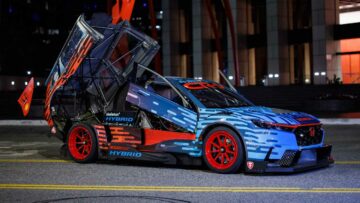In December, Le Mans legend Romain Dumas was at the wheel of the highly modified Porsche 911 Carrera 4S that broke the altitude record for wheeled vehicles. But Dumas isn’t the only connection this record-setting 911 has to the legendary 24-hour enduro. Its trick suspension was originally meant for Le Mans.
While much of this Carrera’s drivetrain is unmodified, its suspension has been totally redone, equipped with a system Porsche calls the Warp Connector. Originally created for the Le Mans-winning 919 Hybrid, it was shelved early on in that car’s development and unused until this project.
It’s unlike the suspension system in any other Porsche.
How It Works
Instead of letting each corner operate independently, the Warp Connector suspension goes in the opposite direction, interconnecting all four corners for maximum traction. The front axle and rear axle are each connected transversely to their own centrally mounted springs and dampers. For the front axle, that spring and damper setup is located under the hood, just in front of the windshield cowl. For the rear axle, the spring and damper can be found at the rear of the cabin, where you’d normally find the parcel shelf.
Above, a 3D diagram of the Warp Connector suspension provided by Porsche.
The “connector” in the Warp Connector is the final piece of the puzzle. It’s a solid bar that connects each axle longitudinally via a series of pivot points. The bar creates a sort of twist tension between the front and rear, so if one axle articulates a certain way, the bar enacts a force onto the other axle, coaxing it to articulate in the opposite direction.
This means any upward force going into a wheel — say, one tire driving over a big rock — is translated into downwards force to the other three wheels. The opposite wheel receives its downward force through the centralized spring and damper, while the opposite axle receives its downward forces through the Warp Connector bar. The system’s interconnected nature means all four corners are acting on each other at all times, pushing each other to stay connected to the surface below. The result is a 911 that can maintain its stability over large rocks, dips, and undulations. Here’s a demonstration of the system in action:

Engineers were hesitant to construct a full-size prototype with such a drastically different suspension setup. So they built a scale model first.
“[The suspension’s] inventor came with the idea to build an RC model car with exactly the same system,” says Sven Schaarschmidt, chassis engineer for the record-setting car. “It looked a bit different than in the real car, but the working principle was exactly the same thing. We were able to play with the car on a desk, moving the wheels and looking at all the connections. It gave us an idea if it could really work in a big car.”
One question remains: If the Warp Connector works so well in this 911, why was it dropped from the 919 project?
“The problem was that [the 919 engineers] had a number of other issues to solve with the car,” Schaarschmidt told Motor1. “To make it easier to analyze all the issues, They wanted to simplify the car and remove the system. Then the car was working so well that they saw no reason to bring it back.”
Porsche won’t say whether it plans to do more with the Warp Connector concept, though considering just how much space it takes up in the record-setting 911, viable production applications are likely few and far between. Still, it’s an impressive bit of engineering that’s worth highlighting. It helped achieve a world record, after all.
If we had to guess, the Warp Connector’s reappearance would likely come in a motorsport application, seeing as that’s where it originated, anyway. Race cars don’t need to worry about occupying a little extra cabin or storage space, making it an appealing choice for competition use. But that’s just speculation on our end.
- SEO Powered Content & PR Distribution. Get Amplified Today.
- PlatoData.Network Vertical Generative Ai. Empower Yourself. Access Here.
- PlatoAiStream. Web3 Intelligence. Knowledge Amplified. Access Here.
- PlatoESG. Carbon, CleanTech, Energy, Environment, Solar, Waste Management. Access Here.
- PlatoHealth. Biotech and Clinical Trials Intelligence. Access Here.
- Source: https://www.motor1.com/news/704836/porsche-911-altitude-record-car-suspension-explained/
- :has
- :is
- :where
- $UP
- 1
- 100
- 16
- 3d
- 49
- 8
- 9
- a
- Able
- About
- Achieve
- acting
- Action
- After
- All
- an
- analyze
- and
- any
- anyway
- appealing
- Application
- applications
- ARE
- articulate
- AS
- At
- back
- bar
- BE
- been
- below
- between
- Big
- Bit
- bring
- Broke
- build
- built
- but
- by
- Calls
- came
- CAN
- car
- cars
- centralized
- certain
- chassis
- choice
- come
- competition
- concept
- connected
- connection
- Connections
- connects
- considering
- construct
- content
- Corner
- corners
- could
- crawler
- created
- creates
- data
- December
- desk
- developed
- Development
- different
- direction
- do
- Dont
- downward
- drastically
- driving
- dropped
- each
- Early
- easier
- end
- engineer
- Engineering
- Engineers
- equipped
- exactly
- extra
- false
- far
- few
- final
- Find
- First
- For
- Force
- Forces
- found
- four
- from
- front
- gave
- Goes
- going
- had
- helped
- Hesitant
- highlighting
- highly
- hood
- How
- HTTPS
- Hybrid
- idea
- if
- image
- impressive
- in
- independently
- interconnected
- interconnecting
- into
- issues
- IT
- ITS
- jpg
- just
- large
- legendary
- letting
- likely
- little
- located
- looked
- looking
- maintain
- make
- Making
- max-width
- maximum
- means
- meant
- model
- modified
- more
- motorsport
- moving
- much
- Nature
- Need
- no
- None
- normally
- number
- of
- off
- on
- ONE
- only
- onto
- operate
- opposite
- or
- originally
- originated
- Other
- our
- over
- own
- piece
- Pivot
- plans
- plato
- Plato Data Intelligence
- PlatoData
- Play
- points
- Porsche
- principle
- Problem
- Production
- project
- prototype
- provided
- Pushing
- puzzle
- question
- Race
- real
- really
- reason
- receives
- record
- remains
- remove
- result
- Rock
- s
- same
- saw
- say
- says
- Scale
- seeing
- Series
- setup
- Shelf
- simplify
- So
- solid
- SOLVE
- Space
- speculation
- spring
- Stability
- stay
- Still
- storage
- such
- Surface
- suspension
- system
- takes
- than
- that
- The
- the cabin
- their
- then
- they
- thing
- this
- though?
- three
- Through
- times
- tire
- to
- told
- TOTALLY
- traction
- translated
- true
- twist
- under
- unlike
- until
- unused
- upward
- us
- use
- Vehicles
- via
- viable
- wanted
- was
- Way..
- we
- webp
- WELL
- were
- Wheel
- whether
- while
- why
- with
- Work
- working
- works
- world
- worry
- worth
- would
- zephyrnet











